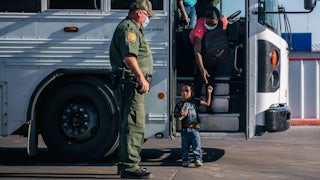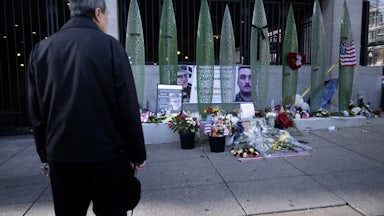Very little surprises Larry Cox anymore. Thirty years of humanitarian work at the U.S.-Mexico border will erode many commonplace human emotions, and for Cox, surprise is one of them. In late September, the refuge he helped start and run in the Mexican border town of Matamoros was bracing for an influx of Haitian asylum-seekers. Earlier that month, about 400 miles west of him in Del Rio, Texas, 15,000 Haitian migrants had gathered in a sprawling encampment on the banks of the river that separates the two countries. The Biden administration quickly moved to dismantle the camp, summarily deporting thousands of its residents in the process. The rapid response may have resolved some of the bad P.R. the crisis produced, but its aftershocks continue to ripple elsewhere along the border. And so, as Cox calculated how overcapacity his shelter was once again about to become, he felt some fatigue but certainly no surprise.
This is not the first time that his refuge, Casa de Paz, has received Haitian asylum-seekers. Some who are there now arrived months before the Del Rio disaster took place. One of them, a wiry 27-year-old from Cap-Haitien named Eliphete Cemerant, has lived at Casa de Paz since July. He numbers among the 65 people now waiting at Cox’s respite center with little likelihood of making it legally into the United States. Cemerant had considered making his way to Ciudad Acuña, across the border from Del Rio, a locale now infamous for images of U.S. Border Patrol agents on horseback chasing Haitians, their reins swinging overhead like whips. Though word had spread through border towns that Haitians were crossing into the U.S. at Del Rio, Cemerant had also heard about Casa de Paz, and instead journeyed east from Tijuana to Monterrey, and finally, to Matamoros.
As Cemerant and I spoke by phone in the early evening hours of September 23, Border Patrol was sweeping the camp under the Del Rio International Bridge. The more fortunate of those asylum-seekers were paroled into the U.S. and strapped with ankle monitors to ensure compliance with immigration authorities. But 5,500 others, including families with small children, were ushered onto flights and swiftly repatriated to Haiti, a country embroiled in the aftermath of the assassination of its former president, Jovenel Moïse, and still reeling from a 7.2-magnitude earthquake that killed 2,100 people and left almost 10,000 injured, just a month after Moïse’s death.
Following the earthquake, Unicef reported that 1.2 million people in Haiti had been affected and that roughly half a million Haitian children had little access to shelter, potable water, health care, or food. Fallout from Moïse’s assassination has exacerbated gang warfare and rendered swaths of Port-au-Prince, as well as the main thoroughfare connecting the capital to the rest of the nation, largely inaccessible. Such are the conditions to which the Biden administration is returning the thousands of migrants deported in September on what some human rights advocates have called “death flights.”
As waves of his compatriots go back to Haiti, Cemerant lingers in limbo at Casa de Paz. Time moves slowly for him there, as it does for so many condemned to wait on the threshold of the U.S. “The feeling of boredom is difficult,” he told me, adding that he anticipated some eventual change in U.S. immigration policy. “Then I’ll make it in.”
It is a gamble for Cemerant to hang his hopes on any benevolent gesture from Washington. As the Del Rio situation proved, whether the White House is under Democratic or Republican control, it is exclusion—not humanitarianism—that constitutes the lifeblood of U.S. immigration policy. Over the course of his presidential campaign, Joe Biden promised to make the U.S. immigration system more humane and to reopen legal avenues for seeking asylum at the border. So far, however, his policy has diverged little from the Trump administration’s. In particular, he has maintained Title 42, an esoteric public health provision that Trump seized upon at the start of the Covid-19 pandemic effectively to close the southern border to people entering the U.S. from a country where a “quarantinable communicable disease exists.”
The Biden administration has made some minor exemptions to Title 42: In March it began admitting a small number of families per day, following a lawsuit brought by the American Civil Liberties Union, and two months later it began allowing 250 “vulnerable” individuals into the U.S. each day to pursue their claims. Unaccompanied children have also been exempted from the policy, and more recently, a federal judge blocked the Biden administration’s use of Title 42 as grounds for expelling migrant families. Beyond these exceptions, the border remains closed to asylum-seekers.
Even so, Haitians and many others continue to push north, all the more desperate after a year of economic and natural disasters. “What many forget is that a lot of these people would prefer to live in their home countries if they could,” Ninaj Raoul, head of the New York–based organization Haitian Women for Haitian Refugees, told me. “They are migrating because they have to in order to survive.”
A less-than-warm reception is certainly not new for migrants at the southern border, and perhaps even less so for those from Haiti. The gathering at Del Rio resembles the expansive migrant camps that resulted from the Trump administration’s “Migrant Protection Protocols,” also referred to as the Remain in Mexico policy. MPP forced roughly 70,000 asylum-seekers to wait in Mexico while their claims were processed, rather than temporarily admitting them into the U.S., where they would be away from the violence and human trafficking that plagues many Mexican border towns. The Biden administration officially ended that policy in June, but it has since been tentatively restarted amid a court battle.
The camp at Matamoros was perhaps the most egregious to emerge under MPP. Over its several years in existence, more than 3,000 people languished there in crowded tents with minimal access to health care, regular food, or running water. In February 2020, a month before Title 42 came into effect and while MPP remained in place, I rode along with Larry Cox from his home in Los Fresnos, Texas, across the border to the giant bridge encampment. At the time, Cox drove that route nearly every day, carrying school and medical supplies, children’s toys, brooms, and Bibles, weaving a web of human necessity back and forth through the borderlands. Once at the vast encampment, he would collect some of the most vulnerable asylum-seekers and bring them to his shelter, at that time an intentionally inconspicuous white stucco building located in a part of Matamoros called the Colonia Derechos Humanos. There, for as long as the Casa was able to support them, they would receive meals, childcare, legal aid, and basic health care.
The resources Casa de Paz could offer were initially intended for short-term stays, but MPP and now Title 42 have led asylum-seekers to linger, in some cases for more than a year. Casa de Paz, like other humanitarian initiatives attempting to stymy the swell of human suffering at the border, continues to buckle under that weight.
Since the callous end of the Del Rio crisis, still more Haitian asylum-seekers have come to Casa de Paz, and more will almost certainly arrive. The Washington Post recently reported that somewhere between 60,000 and 80,000 Haitians are heading to the U.S. by sea or overland from other countries in the Americas. Like Eliphete Cemerant, many left Haiti years ago, in the aftermath of the devastating 2010 earthquake that killed an estimated 220,000 people. Haitians who subsequently found temporary stability in South America are now making their way north as work opportunities dwindle and their legal status shifts.
To be a Haitian asylum-seeker knocking at the door of the U.S. is to stand at perhaps the most visible convergence of race and empire imaginable in this hemisphere. Citizens of the first free Black republic in the Americas, Haitian migrants have endured all of America’s rampant anti-Blackness, as well as its often deadly and racially motivated immigrant exclusion. The first mass Haitian emigration began during the Cold War under dictator François “Papa Doc” Duvalier and continued under his son and successor, Jean-Claude “Baby Doc” Duvalier. Both leaders enlisted a personal, militarized security force, known colloquially as the Tontons Macoutes, who surveilled, extorted, and disappeared tens of thousands of Haitians. Despite these abuses, the U.S. supported the Duvaliers financially and militarily, in part because they saw the alliance as one means of containing Cuba’s Communist government across the Windward Passage that separates the two island nations.
That stretch of water took on new significance following the Duvalier era. In the early 1990s, 68,000 Haitians set out across it by boat following a violent coup that ousted the nation’s first democratically elected president, Jean-Bertrand Aristide. Amid the outflow, the U.S. Coast Guard began intercepting the boats in international waters, sometimes setting them aflame or sinking them beneath the waters of the Caribbean, and promptly depositing their occupants at the U.S. Navy base at Guantánamo Bay. By June 1993, 40,000 Haitians had been detained in what became America’s first experiment in mass incarceration at Guantánamo. In an echo of that sinister epoch, the Biden administration recently put out a request for Haitian Creole–speaking guards to help run a migrant detention center at the base, near the notorious “war on terror” prison.
The Haitian internment at Guantánamo not only set a precedent for migrant detention but also played into the long U.S. tradition of viewing Black and brown bodies as a vector for disease. Just as Covid-19 justified the expulsion of Haitians under Title 42, the HIV crisis of the 1980s and ’90s colored Americans’ response to Haitian migrants. Asylum-seekers who tested positive for the virus were refused passage into the U.S. in accordance with a 1987 law banning HIV-positive persons from entering the country (a law sponsored by then-Senator Jesse Helms, whose other legislative undertakings included fighting desegregation and filibustering the creation of Martin Luther King Jr. Day as a national holiday). For those refugees who had passed asylum-screening protocols and could not be returned to Haiti according to U.S. and international laws, Guantánamo became a legal and existential purgatory; they could neither return home nor enter the U.S. The squalor the Haitian refugees were forced to endure, coupled with the legal catch-22 that kept them stranded at Guantánamo—in some cases for years—led one federal judge to describe the crisis as “an HIV prison camp.” This legacy is not lost to the tides of history: Recall Trump’s reported conviction that Haitians “all have AIDS.”
The through lines are especially clear to Ninaj Raoul, who began her career as an activist working as a Creole translator at Guantánamo in 1992. Both then and now, Raoul feels the mixed messaging of empty humanitarian rhetoric is making advocacy work harder. “The hypocrisy of the Democratic Party is in many ways the problem,” she told me. “At least Trump stated his racism out loud.” To Raoul, the Border Patrol’s brutality at Del Rio, horrifying as it was, exposed the true nature of Biden’s approach to immigration. “It’s like watching George Floyd get murdered,” she said. “Hard as it is to see our Haitian brothers and sisters go through this, and know that they are being sacrificed, people need to see and understand what we’re up against.”
These stakes are certainly not lost on Larry Cox. “The policymakers in Washington are displaying mass neurotic behavior,” he told me following Del Rio. “They argue about circumstances that can’t be solved because the positions they take produce those very circumstances.” As for what has motivated his decades of service, Cox feels no particular allegiance to any religious organization or political party. Rather, his work derives from the belief that “if you make a compassionate offering to someone who is suffering, it is consistent with being a follower of Christ.” He has consequently dedicated his life to moving toward human despair in hopes of alleviating it. And so he carries on in the borderlands, where the U.S. has sown no shortage of suffering.






